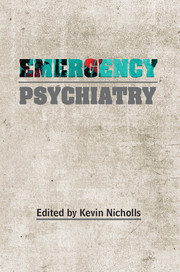Book contents
- Frontmatter
- Contents
- List of contributors
- Acknowledgements
- Preface
- 1 Assessment of suicide risk
- 2 Violence and aggression
- 3 Substance misuse emergencies
- 4 Alcohol and psychiatric emergencies
- 5 Acute psychosis
- 6 Acute side-effects of psychotropic medication
- 7 Emergencies in child and adolescent psychiatry
- 8 The psychiatric intensive care unit
- 9 Safeguarding
- 10 Emergency electroconvulsive therapy
- 11 Life-threatening medical emergencies in a mental health unit
- 12 Emergencies in intellectual disability psychiatry
- 13 Emergencies in older persons’ psychiatry
- 14 Perinatal psychiatric emergencies
- 15 Civilian and military psychological trauma
- 16 Emergencies in liaison psychiatry
- 17 Psychiatric emergencies in deaf people
- 18 Mental health law
- 19 Self-poisoning: aspects of assessment and initial care
- Index
1 - Assessment of suicide risk
Published online by Cambridge University Press: 01 January 2018
- Frontmatter
- Contents
- List of contributors
- Acknowledgements
- Preface
- 1 Assessment of suicide risk
- 2 Violence and aggression
- 3 Substance misuse emergencies
- 4 Alcohol and psychiatric emergencies
- 5 Acute psychosis
- 6 Acute side-effects of psychotropic medication
- 7 Emergencies in child and adolescent psychiatry
- 8 The psychiatric intensive care unit
- 9 Safeguarding
- 10 Emergency electroconvulsive therapy
- 11 Life-threatening medical emergencies in a mental health unit
- 12 Emergencies in intellectual disability psychiatry
- 13 Emergencies in older persons’ psychiatry
- 14 Perinatal psychiatric emergencies
- 15 Civilian and military psychological trauma
- 16 Emergencies in liaison psychiatry
- 17 Psychiatric emergencies in deaf people
- 18 Mental health law
- 19 Self-poisoning: aspects of assessment and initial care
- Index
Summary
Suicide can be defined as self-inflicted death with evidence that the person intended to die (Kaplan & Sadock, 1998; Jacobs et al, 2003). It is a major cause of death: in fact, the tenth most common cause of death worldwide (1.5% of all deaths; Hawton & Heeringen, 2009). Suicide accounts for approximately 5000 deaths per year in the UK and, according to the National Confidential Inquiry into Suicide and Homicide by People with Mental Illness report (2011), this rate has decreased over the past decade. The most common methods of suicide in the UK are hanging, overdose (self-poisoning) and multiple injuries (caused by jumping from a height, for example, or train incidents). It also reports that suicide by hanging has increased, while suicides by carbon-monoxide poisoning, self-poisoning and firearms fatalities have decreased.
Assessing risk in patients presenting with suicidal ideation is fundamental to the practice of psychiatry. A structured and systematic approach that evaluates risk is needed to inform decisions about the patient's care. Many trained professionals report difficulty in assessing risk (Way et al, 1998), and assessment might be more complicated for informal in-patients (Mahal et al, 2009).
Half of all people who die by suicide have had previous contact with mental health services, and half of this group have had contact within the previous 12 months (Department of Health, 2001). This finding is consistent with the National Confidential Inquiry into Suicide and Homicide by People with Mental Illness report (2011), which estimated that 24% of suicides had been in contact with mental health services in the year before death. Predictors of suicide include male gender, substance misuse, increased age, previous suicide attempt, violent method of suicide attempt and history of psychiatric disorder (Nordentoft, 2007).
Key features in assessment
National Health Service trusts and other service providers have varying protocols, or in some cases no protocol at all, for assessing suicide risk. Junior doctors and other professionals fear that they are ill-equipped to assess suicide potential (Bongar & Harmatz, 1991; Boris & Fritz, 1998; Sudak et al, 2007). The effects of clinical experience on professional judgement have not been sufficiently evaluated; neither have the intuitive benefits of empathy and non-judgmental rapport on outcome been confirmed.
- Type
- Chapter
- Information
- Emergency Psychiatry , pp. 1 - 11Publisher: Royal College of PsychiatristsPrint publication year: 2015



